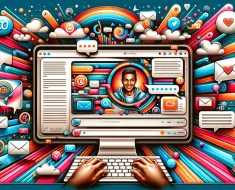In recent years, AI-generated imagery has emerged as a groundbreaking technology, potentially transforming the landscape of visual content creation. This shift raises important questions about the future of stock photography and the role of human creativity in image production.
AI-generated imagery refers to pictures created by artificial intelligence algorithms rather than captured by a camera. These systems can produce strikingly realistic images from text descriptions, often in a matter of seconds. It’s a far cry from the painstaking process of setting up photo shoots, editing raw files, and curating vast libraries of stock images.
The Impact of AI-Generated Imagery on Stock Photography


The advent of AI image generators like DALL-E, Midjourney, and Stable Diffusion has opened up new possibilities for creating visual content. These tools can conjure up almost any imaginable scene or concept, often with impressive detail and realism. For many, this represents an exciting new frontier in creativity and design.
“AI-generated imagery is changing the game,” says Sarah Chen, a digital marketing consultant. “We can now create custom visuals for campaigns on the fly, without the limitations of traditional stock photos”¹.
Indeed, the flexibility of AI-generated images is one of their biggest selling points. Need a picture of a cat riding a unicycle on Mars? An AI can whip that up in seconds, while finding such a specific image in a stock photo library would be nearly impossible.
Pros and Cons of AI-Generated Imagery
Like any new technology, AI-generated imagery comes with its own set of advantages and drawbacks:
Pros:
- Unlimited customization: You can create images tailored to your specific needs.
- Rapid creation: Images can be generated in seconds, saving time for creators.
- No licensing concerns: Since these images are created from scratch, you don’t have to worry about copyright issues.
- Potential cost savings: Businesses can reduce costs associated with photo shoots and licensing fees.
- Ability to create previously impossible images: AI can visualize concepts that don’t exist in reality.
Cons:
- Potential lack of authenticity: Some argue that AI-generated images may lack the emotional depth of human-created art.
- Ethical concerns about AI-generated content: Issues such as bias in AI training data can lead to problematic representations 1.
- Inconsistent quality: While many AI-generated images are stunning, others can be bizarre or low-quality.
- Loss of human touch and artistry: Critics worry that reliance on AI diminishes the unique perspective of human artists.
- Potential job displacement for photographers: As AI tools become more prevalent, traditional photographers may find it harder to compete.
Changing Landscape for Marketers


For marketers, AI-generated imagery offers exciting new possibilities. It allows for more personalized and targeted visual content, potentially improving engagement and conversion rates.
“We can now create visuals that perfectly match our brand and message,” says Emily Zhao, a content marketer. “It’s opening up new creative avenues we couldn’t explore before due to budget or resource constraints”³.
However, marketers must also navigate the ethical implications of using AI-generated images. Transparency about the source of visuals may become increasingly important as consumers become more aware of AI-generated content.
The Future of Visual Content
As AI technology continues to advance, we’re likely to see a blending of AI-generated and traditional photography. Stock photo companies are already exploring ways to incorporate AI into their offerings, potentially creating hybrid services that combine the best of both worlds.
“I think we’ll see a convergence of AI and human creativity,” predicts Dr. Alex Patel, an AI researcher. “Imagine photographers using AI to enhance their work or create variations on their photos. It’s not about replacing human artists, but augmenting their capabilities”⁴.
What This Means for Photographers


For photographers, particularly those in the stock photo industry, the rise of AI-generated imagery presents both challenges and opportunities. While it may reduce demand for certain types of stock photos, it also opens up new avenues for creativity and collaboration with AI.
“As photographers, we need to adapt,” says Rodriguez. “Maybe that means focusing more on unique, artistic shots that AI can’t replicate, or learning to use AI tools to enhance our work. It’s about evolving with the technology”⁵.
Conclusion: Evolution, Not Extinction
While AI-generated imagery is undoubtedly changing the visual content landscape, it’s unlikely to completely replace stock photos or traditional photography. Instead, we’re seeing an evolution of the industry, with new tools and techniques complementing existing practices.
The key for businesses, marketers, and creatives will be learning how to effectively integrate AI-generated imagery into their visual strategies. This might involve using AI for quick, custom graphics while relying on stock or custom photography for more significant brand imagery.
As we move forward, the most successful approaches will likely be those that harness the strengths of both AI and human creativity. The end of stock photos? Not quite. But we’re certainly witnessing the dawn of a new era in visual content creation, where AI-generated imagery plays an increasingly important role alongside traditional photography.
References
1. AltexSoft
2. College of Saint Benedict and Saint John’s University
4. Wired
5. Airbrush.ai
Please note, that the author may have used some AI technology to create the content on this website. But please remember, this is a general disclaimer: the author can’t take the blame for any mistakes or missing info. All the content is aimed to be helpful and informative, but it’s provided ‘as is’ with no promises of being complete, accurate, or current. For more details and the full scope of this disclaimer, check out the disclaimer page on the website.





